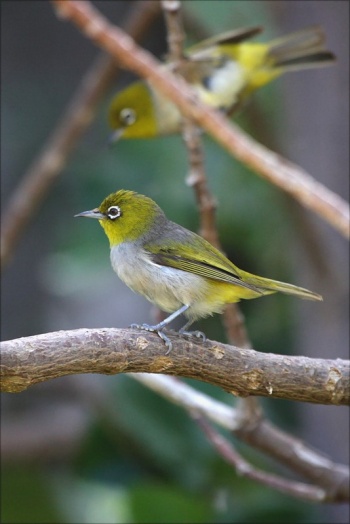- Zosterops lateralis
Includes: Lord Howe White-eye
Identification

Photo © by Mat & Cathy
Lord Howe Island, New South Wales, Australia, December 2007
12cm (4¾ in), 13gm.
Also known as wax-eye, or white-eye, it has a conspicuous white ring around the eye, thus giving the bird its name.
The head and upperparts are olive green with a grey band across the back, which extends around the chest.
The underparts are a peachy brown with white under the tail.
Distribution
An abundant native to Australia and New Zealand.
Recent colonist to New Zealand - 1856, at the settlement stage. The Maori name is Tauhou meaning "Stranger". Was not known in NZ until the middle of the 19th century, but it is thought that a storm caught a migrating flock and diverted them to New Zealand.
As they arrived naturally and colonised NZ on their own, they are protected like other native species.
Also found in New Caledonia, the Loyalty Islands, Vanuatu and Fiji.
Taxonomy
Subspecies
There are 17 subspecies[1]:
- Z. l. chloronotus: South West Western Australia (Shark Bay to far south-western South Australia)
- Z. l. vegetus: North East Queensland (McIlwraith Range to Burdekin River)
- Z. l. cornwalli: East Australia (east-central Queensland to Hunter River, New South Wales)
- Z. l. chlorocephalus: East Queensland (islands of Capricorn coast)
- Z. l. westernensis: South East Australia (southeast New South Wales to Victoria)
- Z. l. pinarochrous: South Australia (Eyre Peninula) to north-western Victoria and adjacent NSW
- Z. l. ochrochrous: King Island (Bass Strait)
- Z. l. lateralis: breeds Tasmania and Flinders Island (Bass Strait); winters in coastal eastern Australia. Also colonized New Zealand in the 19th century, now resident throughout New Zealand (colonized ca 1832) and on Norfolk Island (colonized 1904)
- Z. l. vatensis: North Vanuatu, Banks Group and Torres Island
- Z. l. valuensis: Vanua Lava Island (Vanuatu)
- Z. l. tropicus: Espíritu Santo Island (Vanuatu)
- Z. l. macmillani: Vanuatu (Tanna and Aniwa islands)
- Z. l. nigrescens: Loyalty Islands (Ouvéa and Maré)
- Z. l. melanops: Lifou (Loyalty Islands)
- Z. l. griseonota: New Caledonia
- Z. l. flaviceps: Fiji Archipelago
- Z. l. tephropleurus: Lord Howe Island
The subspecies tephropleurus from Lord Howe Island is sometimes treated as full species, Lord Howe White-eye.
Habitat
Tree cover, up to 1000m
Behaviour
Diet
Silvereyes feed on a variety of foods, invertebrates, fruit, and nectar and will feed in flocks over winter in gardens and parks they have a fine tapered bill and a brush tipped tongue for drinking nectar. They prefer the fruit of native trees but do feed on other fruiting species.
Breeding
As the breeding season approaches the pair break away to form individual territories. They are prolific breeders, often raising 2-3 broods, occasionally as many as 5 per season, with between 2-5 eggs per brood.
Gallery
Click on photo for larger image
Juvenile
Photo © by the late Rookery
Havelock North, New Zealand, December 2016Photo © by craigwilson
Waitati, New Zealand, July 2017
References
- Clements, J. F., T. S. Schulenberg, M. J. Iliff, S. M. Billerman, T. A. Fredericks, B. L. Sullivan, and C. L. Wood. 2019. The eBird/Clements Checklist of Birds of the World: v2019. Downloaded from http://www.birds.cornell.edu/clementschecklist/download/
- van Balen, B. and D. A. Christie (2020). Silvereye (Zosterops lateralis), version 1.0. In Birds of the World (J. del Hoyo, A. Elliott, J. Sargatal, D. A. Christie, and E. de Juana, Editors). Cornell Lab of Ornithology, Ithaca, NY, USA. https://doi.org/10.2173/bow.silver3.01
Recommended Citation
- BirdForum Opus contributors. (2025) Silvereye. In: BirdForum, the forum for wild birds and birding. Retrieved 25 April 2025 from https://www.birdforum.net/opus/Silvereye
External Links
Search specifically for Lord Howe White-eye:
GSearch checked for 2020 platform.1








